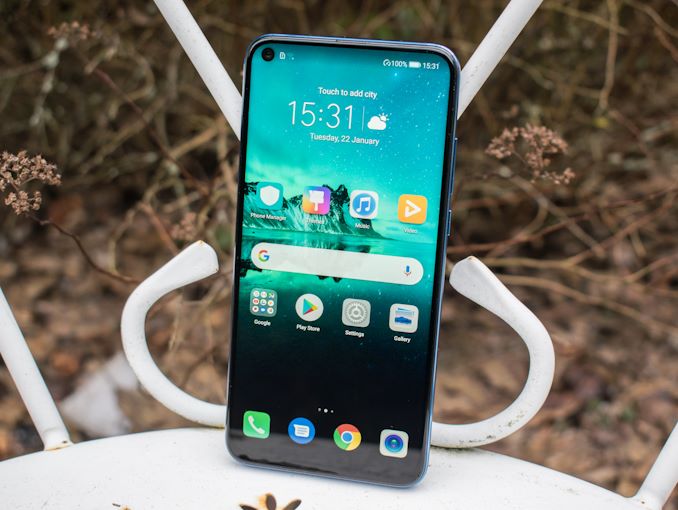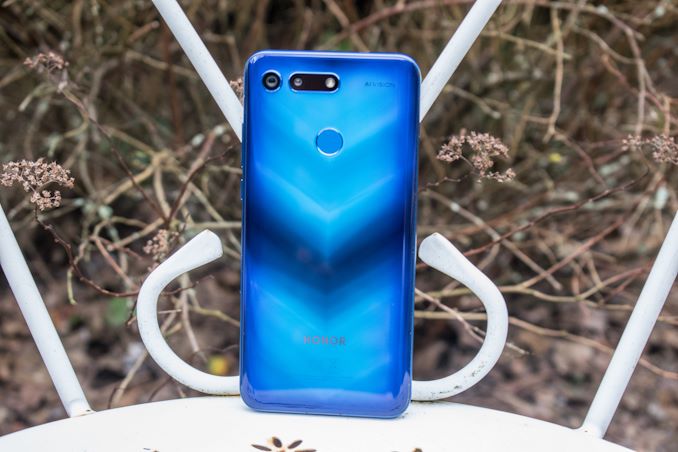Honor Launches The View20: A 48MP Camera Review
by Andrei Frumusanu on January 28, 2019 8:00 AM EST- Posted in
- Smartphones
- Mobile
- Kirin 980
- Honor View20
End Remarks & Conclusion
In many ways, the View20 represents an interesting alternative to Huawei’s most recent available offerings. The phone gets a lot of firsts in terms of features, but also clearly showcases that it isn’t quite the best that the company has to offer with some issues in regards to the overall polish of the product.
The new screen and the company’s first use of a hole-in-display front camera setup is one of the key aspects of the device. The new design works well in my opinion and Honor’s camera hole size and positioning do offer a viable alternative to a display notch. Obviously I still wish the hole would be ever so slightly smaller and take up even less space, however I think it’s a great first step for what we’ll come to see a lot more often in 2019.
What is most disappointing about the View20 screen is the display panel itself. Here the off-axis viewing angles aren’t as competitive and it’s visible that the component is more deserving of a “mid-tier” classification rather that of a higher quality LCD. Huawei’s Mate 20 for example offers a much better quality display panel in this regard, and obviously the phone can’t compete with OLED alternatives such as that of the OnePlus 6/6T. Display calibration, while I haven’t directly covered in the review, isn’t an issue for the View20 as Honor offers accurate display mode settings and also has fine-tuning options to set colour temperature to your preference.
While the LCD’s viewing angles aren’t top-notch, efficiency is very good. The combination of a large battery, the excellent Kirin 980 chipset, as well as an efficient display panel put the View20 at the top of the battery charts among some of the best performing devices out there.
While battery performance is top-notch, it doesn’t come with any compromises as performance of the View20 is also an absolute non-issue, all thanks to the Kirin 980 chipset. The View20 performs as good as the recent Mate 20’s – and actually improves 3D performance as the new heatpipe system allows for sustained performance at or near the peak performance of the GPU, reaching about the similar sustained performance levels as that of the very best Snapdragon 845 devices last year.
Finally, the camera of the View20 had a lot of promise, but in the end it continues the dual-edged nature of these high MP camera sensors. Much like the P20 Pro and Mate 20 Pro’s 40MP sensors, the new 48MP unit of the View20 can achieve some fantastic pictures in terms of detail. However most of the time and in the vast majority of situations, this will also result in a drop of dynamic range that will be noticeable, and most of the time it won’t be worth it compared to the regular pixel-binning mode at 12MP resolution. In this mode, the View20 showcases fantastic exposure results and dynamic range among the top performers in the current smartphone space, but it’s not quite the best in terms of detail retention.
The inclusion of the new 48MP AI Ultra Clear mode really complicates things, this does have tangible advantages over the 48MP mode, however the implementation sometimes just seems buggy, and I’m not sure if this is by design or simply because of immature software. What is really unfortunate is that this again adds a capture mode that adds to the confusion as to when to use what mode in order to get the best results. I really wish Huawei and Honor would streamline the capture experience in this regard as less versed users will have to learn how the camera behaves before being able to get the most out of it.
The TOF sensor at the moment is in practical terms essentially useless – Honor just doesn’t deliver sufficient use-cases for it and the one game that supports it makes it no more than a gimmick. In the future this could be alleviated via software, but as of right now, you might just as well ignore that it’s there, and just treat the View20 as a single-camera phone.
Should I Buy It?
Overall, the View20 is an odd device in terms of its target market. Honor’s marketing materials position the device against the highest flagships, such as the iPhone XS, Galaxy Note9, or OnePlus 6T. The one weak point where the View20 can’t compete with these devices is in screen quality. Even the OnePlus 6T which comes at a similar price range as the 569€ base price of the View20 outdoes it in the screen department, and here I don’t see the hole-in-display camera as some sort of competitive advantage that would give the phone any kind of higher worth price wise.
Camera on the View20 is pretty good – even though I’m torn on these high-MP sensors, in the regular 12MP mode the View20 is plenty competitive with the best devices out there both in daylight and in low-light. Just make sure you know exactly in what capture mode you’re supposed to be in.
What puts the View20 ahead of the competition and really makes it an outstanding worth for its money is the performance and battery life. Here the View20 is clearly punching far above its weight and the inclusion of the Kirin 980 in this lower price tier gives the device a marked advantage.
Overall I don’t think users will be disappointed with the View20 – given its performance, expected battery life, as well as camera performance, even though it’s not a perfect device and has a lot of rough edges or missing some features, for the price it does offer excellent package that is hard to argue against.












37 Comments
View All Comments
apphil - Monday, January 28, 2019 - link
One thing I am extremely curious is the performance of the GPS chip as it is one of the first phones with L5 GPS and this should increase accuracy a lot. Can you guys comment on that or maybe test that, as better navigation and positioning would be a very interesting feature for me.Andrei Frumusanu - Monday, January 28, 2019 - link
One of the benefits of this was in more urban areas with tall buildings, unfortunately I wasn't able to actually test this out. The phone's location APIs also does not disclose whether it sees L5 satellites or not - usually you see it when there's a duplicate ID, however this does not appear on the View20.808Hilo - Monday, January 28, 2019 - link
The cam is disappointing. Can we just have a big sensor and a manual lensring of my choice and 4k or 8k raw at 30fs the back. NOW!!!Its not difficult. Just do it. Nikon in my case. I got a nice selection of 8-50mm lenses and dont want yours.
Engineering a phone is not difficult. Adding a lensring and a big sensor is a breeze.
Valantar - Monday, January 28, 2019 - link
Difficult? Not if you don't care about size, no. The flange distance of the Nikon Z-mount is 16mm, for their F-mount it's 46.5mm. Add a handful of mm to that for the display, and 10 or so for the sensor and shutter array - more if you want IS. That's a chunky phone, even with a Z-mount. And constructing lenses for shorter flange distances with large sensors is _extremely_ difficult, as you'll have to correct for ever more distortions towards the outer parts of the sensor. Of course they could have spacer rings or similar to adapt lenses, but that would kind of defeat the point, no? You wouldn't be able to fit it in your pocket unless you're wearing MC Hammer pants. Also, 8k30 in a phone? At what bitrate, 50Mbps? For any bitrate worth the pixels in 8k, you'd need storage in the several-hundred-GB amounts for even a collection of short clips, and the processing power needed would require large interchangeable batteries - unless you want your phone to die after filming for 5 minutes? And good luck getting that video material off a phone with non-removable storage in a reasonable amount of time. I suppose you'd want it to have an SSD bay too?hanselltc - Monday, January 28, 2019 - link
>Engineering a phone is not difficultbuild ur own phone m8 :v
Manch - Monday, January 28, 2019 - link
TOF sensor would be great for 3D scanning! Why not have an app to take advantage!jabber - Monday, January 28, 2019 - link
You know I'd settle for a truly excellent 8MP main cam to be honest.Forget going mega megapixel. Just get the fundamentals right first.
shabby - Monday, January 28, 2019 - link
Nothing to do with megapixels in this case, the sensor is great, everyone uses sony sensors, its the isp and software that sucks. The isp on these chinese made soc's is way behind the snapdragon isp.Heck even sony doesn't know how to fully take advantage of its own sensor. The pixel 3 and pocophone use the same sensor and we all know which phone takes the best photo's.
Midwayman - Monday, January 28, 2019 - link
Yes. This. Especially with more phones putting on more than a single lens. I care way more about the quality of the pixels than the quantity of pixels. 48mp photos just take up more space if they are just a grainy mess in anything but the brightest light.jabber - Tuesday, January 29, 2019 - link
Exactly. They spend all the time fussing over the sensor and then throw out the lens/flash/focusing/software/compression/NR features.I bet the sensors from 4 years ago would beat most current flagships if they bothered to spend more than a weeks development on all the other fundamentals.